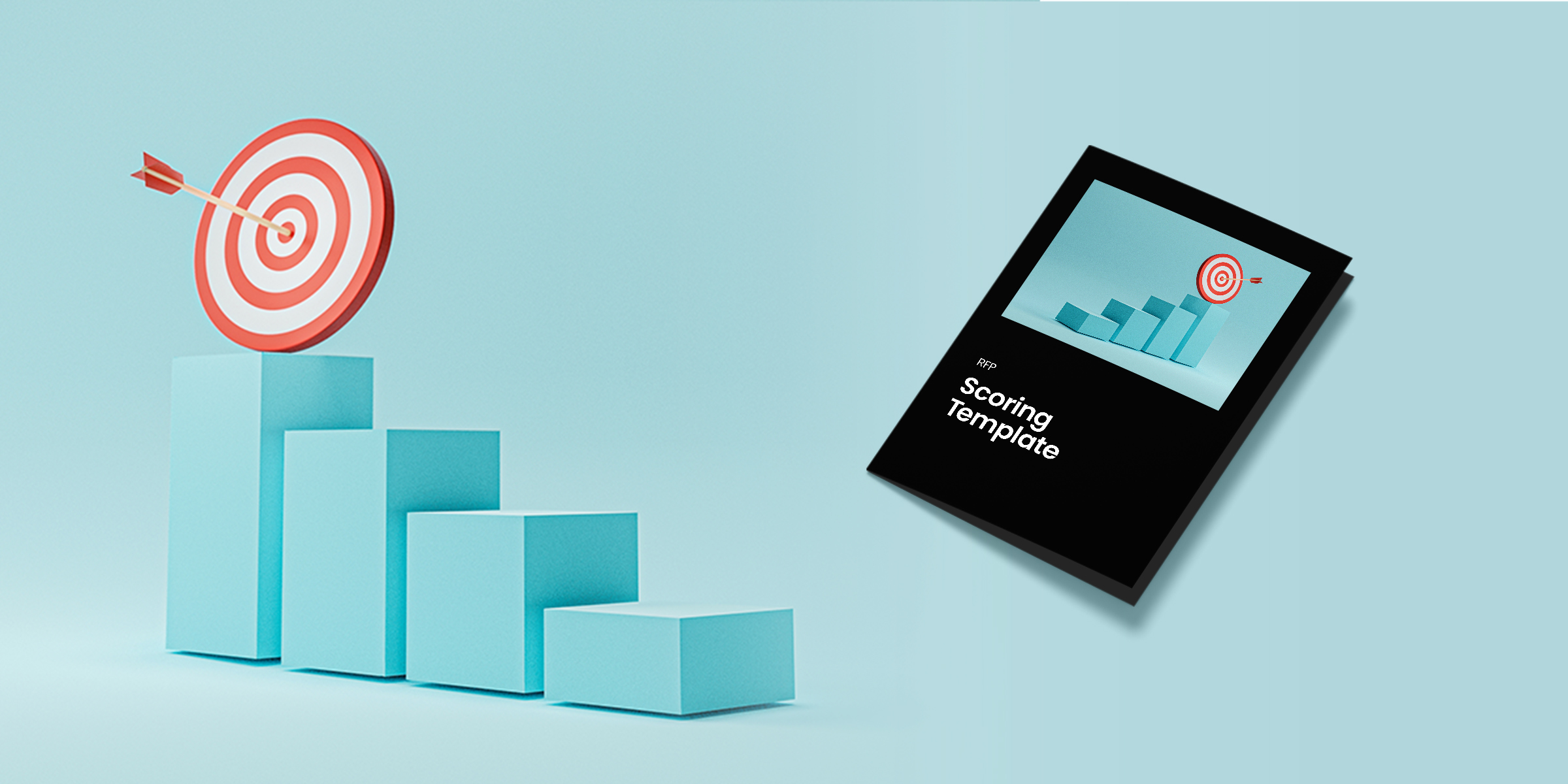
RFP Scoring Template
Unlock better decision-making with our RFP scoring template. Streamline evaluations, compare vendors effectively, and ensure you select the best fit every time. Optimize your procurement process today

In the rapidly evolving business world, the criticality of strategic purchasing has dramatically escalated. Strategic purchasing, or procurement, has shifted from a simple transactional process to a multifaceted strategic undertaking that contributes significantly to a company’s competitive positioning and bottom-line results. This comprehensive white paper delves deeper into the intricacies of strategic purchasing, shedding light on its significance, advantages, and offers a detailed guide on efficiently integrating this crucial process into your business practices.
Strategic purchasing stands as a structured, well-thought-out approach towards procurement, where purchasing decisions align seamlessly with the broader strategic vision of the organization. This approach gives due importance to both immediate and long-term objectives of the business, while also emphasizing the cultivation of durable relationships with vendors. The ultimate goal being a sustained supply of high-quality products and services at competitive pricing, delivered on time.
In the fiercely competitive global marketplace, strategic purchasing plays a transformative role for organizations due to the following reasons:
Strategic purchasing streamlines procurement processes to ensure premium quality products and services at the most competitive prices, thereby driving cost savings.
An efficient approach to purchasing guarantees a reliable, robust supply chain management system, minimizing potential delays and disruptions.
Building robust vendor relationships, improved quality control, and cost-effectiveness can give organizations a formidable edge in the market.
The advantages of incorporating strategic purchasing into your business model are extensive:
1. Enhanced Supplier Relationships: One of the most profound benefits of strategic purchasing is the nurturing of strong, long-term relationships with suppliers. By not viewing suppliers as mere transactional partners but instead as strategic collaborators, organizations can foster a climate of mutual growth and innovation.
The benefits of this approach are manifold, from improved communication and transparency to superior service quality and preferential pricing arrangements. Over time, these relationships can evolve into strategic partnerships that deliver unparalleled value to both parties.
2. Effective Risk Management: Strategic purchasing also acts as a powerful tool for managing and mitigating risks associated with procurement. By carefully selecting reliable vendors, scrutinizing their operational and financial stability, and devising robust contingency plans, businesses can insulate themselves from numerous procurement-related risks. This includes supply disruptions, quality issues, and potential price volatility.
As such, strategic purchasing becomes an essential part of a company’s risk management framework, enabling it to navigate the unpredictable terrain of the global business landscape more effectively.
3. Superior Quality Control: With strategic purchasing, quality control is no longer a reactive process, but a proactive one. By collaborating closely with suppliers and emphasizing continuous improvement, organizations can embed quality into every stage of the procurement process.
This results in products and services that consistently meet, if not exceed, quality expectations. Furthermore, such a focus on quality ensures that organizations adhere to regulatory standards, maintain their reputation, and increase customer satisfaction, thus positively impacting their bottom line.
4. Significant Cost Reduction: Strategic purchasing transcends beyond the traditional focus on price to achieve cost reduction on a more holistic level. It leverages several tools and techniques to achieve this, including economies of scale, bulk purchasing, strategic sourcing, and skilled negotiations.
By optimizing the total cost of ownership – which includes product cost, operational costs, logistic costs, and even after-sales service costs – businesses can drive cost efficiencies throughout their supply chain. These cost savings can then be reinvested in other strategic initiatives that contribute to the organization’s growth.
Implementing strategic purchasing in an organization requires more than a superficial shift in procurement operations. It calls for a comprehensive, well-thought-out strategy that permeates the entire purchasing function. Here’s how organizations can go about integrating strategic purchasing effectively:
1. Comprehensive Analysis of the Current Purchasing Process: Before transforming procurement operations, it’s crucial to understand the current purchasing landscape. A detailed analysis of existing practices offers invaluable insights into their strengths and weaknesses. It uncovers opportunities for improvement and highlights potential roadblocks.
By examining everything from supplier selection and contract negotiation to quality control and relationship management, organizations can gain a holistic view of their procurement function. This helps create a strong foundation for implementing strategic purchasing.
2. Alignment with Organizational Vision: Strategic purchasing is not an isolated function; it needs to be deeply intertwined with the organization’s broader goals and strategy. The procurement strategy must reflect the company’s vision, mission, and objectives.
It needs to account for future growth plans, anticipated market trends, and potential business risks. By aligning strategic purchasing with the organizational vision, businesses ensure that every procurement decision contributes to their larger strategic goals.
3. Identification and Building Relations with Key Suppliers: An integral aspect of strategic purchasing is identifying and fostering relationships with key suppliers. These are suppliers that provide crucial products or services, offer competitive pricing, deliver high quality, and have reliable delivery schedules.
Building strong relationships with these suppliers can help secure preferential terms, ensure consistent supply, and open up opportunities for collaborative innovation. Moreover, it enables organizations to create a robust supplier network that supports their strategic objectives.
4. Leverage Technology for Enhanced Efficiency: The integration of technology is another crucial element in implementing strategic purchasing. Advanced procurement software and digital tools can streamline processes, improve transparency, and enhance efficiency.
Automation can speed up routine tasks, artificial intelligence can drive data-driven decision-making, and analytics can offer valuable insights into supplier performance and market trends. By leveraging technology, organizations can not only enhance their procurement operations but also position themselves for future advancements in the field.
5. Continuous Monitoring and Fine-tuning: The strategic purchasing process isn’t a one-and-done initiative. It requires continuous monitoring, evaluation, and fine-tuning. As market dynamics shift, supplier performance varies, and business needs evolve, the procurement strategy needs to adapt.
Regular audits, supplier performance reviews, and stakeholder feedback are vital to ensure the strategic purchasing function remains aligned with the business’s needs and continues to deliver value. It reinforces the fact that strategic purchasing is a dynamic, evolving process that grows with the organization.
Strategic purchasing can prove to be a significant catalyst for organizations, helping them optimize resources, manage risks, and carve out a strong competitive standing. Implementing strategic purchasing requires a profound understanding of the organization’s needs, meticulous planning, and consistent monitoring and adjustment. By integrating strategic purchasing, organizations can metamorphose their purchasing function into a strategic asset that propels growth and success.

Unlock better decision-making with our RFP scoring template. Streamline evaluations, compare vendors effectively, and ensure you select the best fit every time. Optimize your procurement process today

Covering a broad range of industries and scenarios, this Generic RFP template aids in detailing project requirements, establishing evaluation criteria, and soliciting comprehensive vendor proposals.

Designed to demystify complexities, this RFP Process Guide provides step-by-step instructions and best practices for crafting effective RFPS.